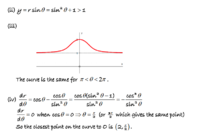You are using an out of date browser. It may not display this or other websites correctly.
You should upgrade or use an alternative browser.
You should upgrade or use an alternative browser.
Q on polar co-ordinates
- Thread starter Sonal7
- Start date
I am also confused about part ii, as it should say y[MATH]\geq1[/MATH] since when [MATH]sin\theta =0[/MATH], y=1
This when you consider the equation y=[MATH]sin^2+1[/MATH], if one were plotting a polar graph it would be infinity when sin [MATH]\theta[/MATH]=0
This when you consider the equation y=[MATH]sin^2+1[/MATH], if one were plotting a polar graph it would be infinity when sin [MATH]\theta[/MATH]=0
I can make much sense of this. When sin [MATH]\theta =0[/MATH] when [MATH]\theta[/MATH]=[MATH]\pi,0[/MATH], the coordinates at [MATH]\theta =0[/MATH] should be equal to 1. I suppose they are plotting the r value so its infinity when [MATH]\theta=0[/MATH]. Yes that makes more sense.What confuses you about the graph in iii? Have you tried plotting a few points?
part I is easy. as sin is an odd function and when you put in sinθ, you can replace these by -sinθ
Any change that you explain what that means? Where are you putting sinθ into? What are the these that can be replaced with sinθ?
Attachments
What ! I thought they wanted us to plot a graph of the function for [MATH]0<\theta<\pi[/MATH] as quoted in the question.But [MATH]\sin\theta = 0[/MATH] doesn't give a point on the graph. For example, [MATH]\theta \ne 0,\pi[/MATH].
LCKurtz
Full Member
- Joined
- May 3, 2019
- Messages
- 475
[MATH]0 < \theta < \pi[/MATH] does not include the end points. Do you understand that the graph is plotted in polar coordinates? They are plotting [MATH]r[/MATH] against [MATH]\theta[/MATH].What ! I thought they wanted us to plot a graph of the function for [MATH]0<\theta<\pi[/MATH] as quoted in the question.
Oh i see, how silly of me not to think of that. so the inequality is correct.0<θ<π means that θ is in between 0 and π but not equal to the endpoints. It does NOT say that 0<θ<π. Is this clear?
Yes I now gathered that it must be r plotted for various values of theta, the range was specified. So when [MATH]\theta =\pi /2[/MATH], r =2.[MATH]0 < \theta < \pi[/MATH] does not include the end points. Do you understand that the graph is plotted in polar coordinates? They are plotting [MATH]r[/MATH] against [MATH]\theta[/MATH].
When theta is [MATH]\pi /2<\theta<0[/MATH] the r is increasing from infinity to 2. I dont think the asymptote is correct.
In my defence, they should not be putting a y on the vertical axis on the graph!
Steven G
Elite Member
- Joined
- Dec 30, 2014
- Messages
- 14,382
Is which inequality correct? If you mean the one that was given to you we must assume yes unless it contradicts something.Oh i see, how silly of me not to think of that. so the inequality is correct.
LCKurtz
Full Member
- Joined
- May 3, 2019
- Messages
- 475
There is nothing wrong with having [MATH]y[/MATH] labeled on the graph. The asymptote is correctly labeled as [MATH]y=1[/MATH]. It might have been helpful had they drawn a polar radius to a point on the graph and labeled [MATH]r[/MATH] and [MATH]\theta[/MATH]. You can verify that [MATH]y=1[/MATH] is the horizontal asymptote because [MATH]y = r\sin\theta = \sin^2\theta + 1 \to 1[/MATH] as [MATH]\theta \to 0[/MATH].I dont think the asymptote is correct.
In my defence, they should not be putting a y on the vertical axis on the graph!
Yes its not a polar graph then, I dont think they are plotting r. They are plotting y. its actually the function y=[MATH]sin^2\theta +1[/MATH]There is nothing wrong with having [MATH]y[/MATH] labeled on the graph. The asymptote is correctly labeled as [MATH]y=1[/MATH]. It might have been helpful had they drawn a polar radius to a point on the graph and labeled [MATH]r[/MATH] and [MATH]\theta[/MATH]. You can verify that [MATH]y=1[/MATH] is the horizontal asymptote because [MATH]y = r\sin\theta = \sin^2\theta + 1 \to 1[/MATH] as [MATH]\theta \to 0[/MATH].
Sorry I was rather talking to myself. It says in part ii show that y>1. I had thought y[MATH]\geq 1[/MATH]But in my defence, they didn't mention the range until part iii. when they state [MATH]0<\theta<pi[/MATH]Is which inequality correct? If you mean the one that was given to you we must assume yes unless it contradicts something.
I understand it now but very confusing as they left me clueless what i was meant to sketching, r or y.No. You are not understanding what I have told you.
Last edited:



